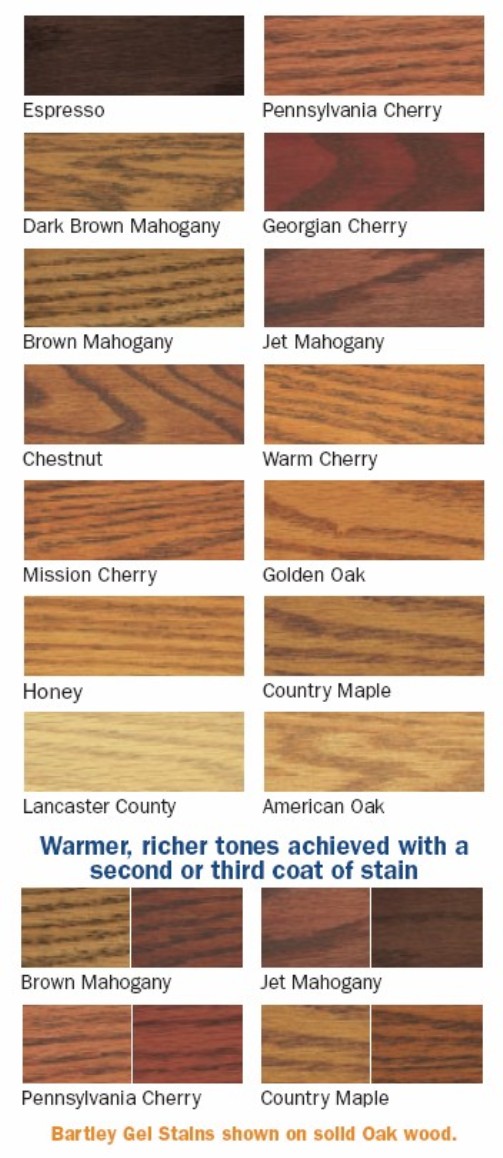BARTLEY GEL FINISHES
THE
WOOD & SHOP
INC EVERYTHING FOR THE HOME
WOODWORKER SINCE 1983
![]()
![]()
![]()
![]()
![]()
![]()
![]()
![]()
![]()
![]()
![]()
![]()
![]()
![]()
![]()
![]()
![]()
![]()
![]()
![]()
![]()
![]()
BARTLEY GEL
FINISHES
BARTLEY
GEL STAINS

|
|
|
|
BARTLEY GEL STAINS & GEL VARNISH
The beauty of Bartley's Gel Stains and Gel Varnish is they are so easy to apply, and they have very low odor. You can even use our products on vertical and overhead surfaces without fear of runs, drips and sags because it is a gel rather than a liquid. To apply, brushes are not required, just a soft lint-free cloth. The Gel Stains are dry to a light touch in seconds and the Gel Varnish is tack-free in minutes, and you do not need to sand or buff with steel wool between coats. Most importantly, Bartley's Gel Stains and Gel Varnish are acclaimed by both professionals and amateurs for ease-of-use and results!
Stain and Varnish Steps Useful Tips
Step 1: Start with a clean, well-sanded surface. With a small cloth or foam brush, apply a generous coat of Bartley Gel Stain to an area no larger than 2 square feet. With a clean, lint free cloth or soft paper towel, immediately wipe off the excess with the grain until the color is uniform and free of smudges. The newly stained surface should be nearly dry to the touch. Your first coat of stain is done! There are no runs, no drips, and no unpleasant odors! For a darker, richer tone, apply a second or third coat of stain (see color chart at right) to add significant depth and richness of color. Allow at least six hours between coats. In humid climates drying time will vary. One of the best features about Bartley stains is there is no sanding between coats. It couldn’t be easier!
Step 2: Note: Certain colors like Georgian Cherry may need longer drying times to prevent lifting when applying clear coats. In hot and humid conditions allow at least 24 hours drying time between coats.
Step 3: After staining, apply two or three coats of Bartley's Gel Varnish for a beautiful and tough hand-rubbed look. Use #0000 steel wool lightly just before your last coat of varnish for a smoother finish. (Be sure to tack the surface before applying the varnish.)
USEFUL TIPS Surface Preparation The surface must be clean, dry, and free of any dust, wax, or grease before staining. New wood should be sanded smooth and free of blemishes. Old finishes should be removed and sanded to a smooth, even texture, and glue spots scraped off and sanded. For a better finish, hand-sand with the grain and on flat surfaces using a sanding block. If planer or molder marks are visible, begin with a coarse paper (80-100 grit); otherwise start with a medium grit (120-150) and finish with a finer grit (180-220). Remember, surfaces sanded with finer sandpaper will result in slightly lighter tones when stained; using coarser paper will result in darker colors. Just before staining, use a tack cloth or rag soaked in mineral spirits to clean the surface.
Common Staining Problems Certain woods like soft pine, maple, and birch often absorb stains unevenly. To help overcome this problem on soft woods and end grains, first apply a coat of Gel Varnish, wipe it nearly dry, and then follow immediately with a coat of Gel Stain. In this case, the varnish acts as a conditioner and eliminates much of the blotchiness. A second or third coat of stain may be necessary to get the desired color. On the harder woods, using a medium grit (120-150) rather than very fine paper before staining usually obtains even results.
Remember, always test stain a hidden area before proceeding with the entire piece. Caution: Touching your work with latex gloves may cause blotchy spots when the varnish is applied.
Clean Up To prevent skinning, place a thin layer of Mineral Spirits in the can before closing. Mineral spirits or paint thinner should be used for clean up.
Intermixing Stains and Varnish Bartley Gel Stains can be intermixed in any combination to create an almost infinite number of colors. The Bartley Gel Varnish can be mixed with the stains to make lighter colors. In both cases, mix well.
Over-staining Even more beautiful tones can be achieved by staining with one color, allowing it to dry for six hours, and then over-staining with a different color. For example, using Brown or Dark Brown Mahogany for the first coat followed by Pennsylvania Cherry will result in reddish brown tones. Pennsylvania Cherry over-stained with Jet Mahogany will create a rich Mahogany color. Because Gel Stains are semi-transparent, the over-staining creates a different look than had the same colors been mixed in a can and then applied. Over-staining has many possibilities. Try it!
Compatibility with Other Finishes Although we recommend our Clear Gel Topcoat, Bartley Gel Stains can be top-coated with most other varnishes, polyurethanes, water base finishes, and lacquers, providing the stains have dried thoroughly. The Gel Varnish can be used to topcoat other stains. To be safe, test an area that will not be visible.
Other Uses Bartley Gel Stains are multi-purpose and excellent for Staining Fiberglass Doors, Wood-graining, Antiquing, Glazing, and Sponging. Storage Bartley Stains do not freeze and can be stored outside. To prevent skinning, place a thin layer of Mineral Spirits in the can before closing. A piece of plastic wrap between the can and lid will also reduce loss of product. When ready to use the product again, simply stir in the Mineral Spirits.
|